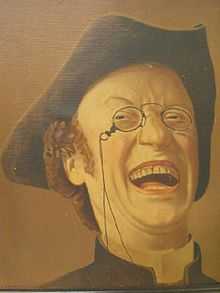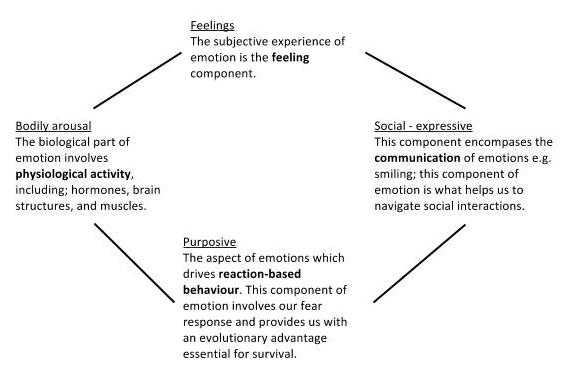Motivation and emotion/Book/2015/Laughter and emotion
< Motivation and emotion < Book < 2015What is the effect of laughter on emotion and why do these effects occur?
|
|
Overview

A man was walking in the street one day when he was brutally beaten and robbed.
As he lay unconscious and bleeding, a psychologist, who happened to be passing by, rushed up to him and exclaimed, "My God! Whoever did this really needs help!"
HA HA HA HA HA HA HA HA HA HA HA laughing is contagious HA HA HA HA.
What is emotion?

Many historical figures over time have attempted to define emotion. Charles Darwin (1872), suggested in his book The Expressions of the emotions in man and animals, “Laughter is essentially an emotional expression, a way of communication to others that one is feeling a particular emotion”.
“We all know emotions at first glance” (Reeve, 2014). There is no one general definition to explain emotion in theoretical studies. However psychologists have linked four components that when combined together help to provide an understanding of emotion. These four components are; feelings, bodily responses, expressive behaviors, and sense of purpose (Reeve, 2014).
Reeve (2014) uses these four components and how they interact with each other to formulate a broad definition. This definition of emotions is “short lived, feeling, purpose, expressive, bodily reactions that helps us to adapt to the opportunities and challenges we face during important life events” (2014, pp.340). The following scenario uses the four components to visualize and explain an emotion:
Interpret stimulus – Someone throws a pie in someone else's face.
- Purposive – An action to take in order to cope with the situation at hand.
- Experience a feeling – Joy, happiness, mirth, or schadenfreude.
- Physiological response – Stomach contractions, staggered breathing, increased heart rate.
- Social expressive behaviors – Laughter and smiling.
By using the proposed four components as previously mentioned we can see that laughter while not being a primary emotion, is the expression of many emotions. Mirth is a primary emotion when discussing laughter and how it affects emotion, as the expression of laughter accompanies this emotion. There are however many different types of emotions that are often expressed through laughter and or smiling.
What is laughter?

Studying humor and laughter and how it effects humans both physiologically and psychologically is called gelotology. Generally speaking laughter is an audible expression of merriment or amusement. It can also be elicited by other types of emotions as a response to certain stimuli. Laughter, in a social and communicative way, can signal positive interactions with others. Laughter is also considered to be contagious. This is why some TV shows still use laughter backing tracks in their final editing process to elicit a reactionary laugh. Not all laughter stems from emotions it can also stem from physical provocation such as tickling. Physical reactions from laughing can include vocal sounds, muscle contractions of the face and diaphragm, and expressive movements.
How is laughter tied in with emotion?
The emotion of mirth is the primary emotion that will be focused on when it comes to laughter; as laughter and smiling are the expressive behaviors that accompany this emotion. The intensity of an emotion determines how strong the expressive display will be. At a low level of intensity the expressions of mirth will be met with less expressive behaviors such as a faint smile. As the emotion gets stronger in intensity, the expressions intensity starts to increase; the smile becomes broader, and is then accompanied by audible chuckling. This shows that when an emotion is at a very high intensity the expressions also become more intense. At a high level intensity of mirth, expressions are likely to be loud guffaws, redness of the face and is accompanied by bodily movements such as throwing one’s head back, slapping one's thighs and so on” (Martin, 2006, p. 155). This scenario illustrates the four components of emotion. Laughter is an expression of multiple emotions. Laughter has physical characteristics and creates a lot of brain activity. As there are many emotions that incorporate laughing, investigating the different types will assist in understanding how laughter is associated with emotions.
Types of laughter

There are a range of emotions that can involve the expression of laughter. There are a few different ways to discern the types of laughter. These are the intensity of laughter, the emotion laughter is expressed with and if the laughter is Duchenne or non-Duchenne. This refers to a laugh or smile being genuine or insincere based on muscle contractions in the face.
When classifying a laugh on the intensity the lower levels start out with smaller expressions which lead to bigger and more boisterous types when the intensity increases (Martin, 2006). These can be describe as having a giggle, chuckle, cackle, chortles, guffaws, and, yes, even the snorter.
We can also discern differences between the types of laughs according to the emotion they are being expressed through.
- Mirth– Amusement as expressed through laughter - this emotion best encapsulates the expression of laughter as a merry pleasant action that is likely to release endorphins.
- Relief - A feeling of reassurance and relaxation following release from anxiety or distress.
- Joy - A feeling of great pleasure and happiness.
- Happiness - The state of being happy.
- Schadenfreude – Pleasure derived from someone else’s misfortune.
All these positive emotions are expressed with happiness, however, laughter can also be elicited by negative emotion to and at inopportune times. An example is being told of this is being told off by a boss and for an unexplained reason you decide to have a giggle. The emotions in which can cause this outburst of laughter include:
- Embarrassment
- Anxiousness
- Confusion
These are examples of emotions that can result in nervous laughter – nervous laughter is where the emotional expression is generated from alarm, discomfort or stressful social situations, rather than feelings such a mirth and joy.
An interesting study conducted by Stanley Milgram (1963) was used to investigate why people blindly follow authoritative orders. He achieved this by shocking participants with electrical volts. The intensity increased up to 450 volts. In his results it is mentioned that many patients who heard the screams of pain from other participants, began to laugh nervously.
Other types of laughter that aren’t as easily aligned with the above emotions are:
- Paradoxical laughter - This laughter can indicate an unstable mood. It is an exaggerated expression which does not fit in with external events. This uncontrollable laughter is generally viewed as inappropriate. This laughter is also considered to come from an abnormal state of mind and can be caused by certain drug use and mental illness.
- Courtesy laugh – The courtesy laugh is an interesting one as it is a laugh that we produce when something isn’t that mirthful but we conjure this expression not to hurt their feelings or emotions.
- Evil laughter – Evil laughter is just laughter that is coming from an evil person. This in used more in books and on TV, and has a structure that looks like mwahahaha. Some fictitious people that have an evil laugh are Wario, Mr Burns, Dr Evil and the joker. It is good to cover all bases.
Two alternative ways of describing types of laughter has been outlined as Duchenne and non-Duchenne laughter (Gervais, Wilson, 2005). Duchenne is a smile or a laugh in which incorporates more muscles in the face. This can be seen in the muscles contractions around the eyes, this is referred to as a Duchenne smile. Laughter and smiling that do not incorporate these muscle contractions are seen as fake or non-Duchenne expressions. Gervais and Wilson (2005) refer to these types of laughter and smiling as expressions from an evolutionary standpoint, adapted to communicate in social situations.
The brain and laughter
Researchers have found that no one area of the brain is solely responsible for laughter. The brain has many regions that activate when a person expresses laughter. However emotional responses in the brain are associated with the frontal lobe and the limbic system areas such as the amygdala and hippocampus. Emotional responses in the brain can usually be localized to specific areas of the brain. This is not the case with laughter. Derks (1997) and fellow researchers looked at brain activity and its associations with laughter. They found the following results in their study:
- 0 milliseconds (ms) – The left hemisphere activity corresponds to word processing of the joke.
- 1 – 60ms – Right hemisphere activity expands, which suggests a shift in attention.
- 60 – 120ms – More right hemisphere activity continues. This is linked to analysis of the joke
- After 120ms – Both hemispheres show positive activity, this shows there is both verbal and pattern evaluation happening.
- 180ms – Activity becomes more positive and spreads to the occipital lobe; this would suggest sensory and imaginal processing of the joke would take place.
- 240 – 300ms – Activity in both hemispheres contributes maximum activity for the positive waves (P300)
- 400ms – If a negative charge in the brain occurs, would result in laughter (N400), if the charge remained positive no laughter would occur.
Laughter’s effect on the brain is not localized to one area (Derks , Gillikin, Bartolome-Rull, & Bogart, 1997). It is involved throughout the cerebral cortex. This could be a potential reason for why we use laughter to express multiple emotions, both positive and negative.
Laughter/humour theories
.jpg)
Relief theory
Relief theory is one of the theories that is used to try explain humor and laughter. This theory was adopted by Sigmund Freud which he based his psychoanalytic theories on. Sigmund Freud’s ideas do not provide an overall account of humor in the modern day.
“However the framework he provided about the intrapsychic functions of humor and there application to social communication provided fundamental groundwork. This has allowed researchers to re-conceptualize Freud’s theory. This theory aims to understand why we sometimes laugh when we are upset or angry” (Martin, 2006, p. 43).
In summary, the relief theory is used as a social expressive instrument to overcome a built up tension within our systems. The overall psychoanalytic idea is that psychological tension is reduced through laughter as a coping mechanism.
Superiority theory
Most of us have all sat on YouTube watching fail videos for hours on end. The superiority theory tries to explain why we laugh at others misfortunes. An example of this is when children make fun and laugh at other kids in the playground. (Martin, 2006) This is a more aggressive side of humor. Early ideas on this theory can be traced back to Aristotle. "The persons with whom we get angry are those who laugh, mock, or jeer at us, for such conduct is insolent" (Rhetoric 2.379b) (as cited in Perks, 2012). Perks (2012) says that from a victim’s perspective this quote best demonstrates superiority theory through a interpersonal exchange of emotions. In summary, the superiority theory suggests that we express this joy at the misfortune of others because we feel superior to them. This theory runs parallel with the term schadenfreude. The amusement is the result of an increase in self-esteem caused by a “downward social comparison” (Ferguson & Ford, 2008, p. 288).
Incongruity theory
The incongruity theory is when humor arises when logic and familiarity are in-congruent. In other words it is when humor was expected to go one way and then is replaced with something unexpected. This can be seen in many stand-up comedian performances. An example of the incongruity theory in humor is:
'There are two fish in a tank, one turns to the other and says, ‘do you know how to drive this thing?’'
This is a common example of a situation that is in-congruent with logic and familiarity. Some theorists suggests that incongruity theory is one of the best theories to describe humor. This is because it is broad and incorporates a common style of comedy.
Positive aspects of laughter
Short term effects
A good laugh has many positive short-term effects. When you start to laugh, mentally it can act as a stress release. Laughter also creates physical changes in the body. Laughter can:
- Stimulate organs - Laughter enhances your intake of oxygen-rich air. A cooperative effect on the respiratory and cardiovascular systems makes oxygen available to the blood and body cells (Marieb & Hoehn, 2010). This stimulates many organs in the body such as your heart, lungs and muscles; it also increases the endorphin's that are released by your brain.
- Activate and relieve stress response - Laughter engages and then disengages with peoples stress responses. It also increases your heart rate and blood pressure. These responses result in a relaxed sensation. Berk and Tan (2006) suggest that the anticipations of a mirthful laughter experience is enough to produce endorphin's, neuropeptide and neuroendocrine hormones (Human Growth Hormones). They conclude that their findings may be beneficial in stress reduction. Laughter acts as a kind of eustress or 'positive/good stress' event” (Berk & Tan, 2006).
- Soothe tension - Mirthful laughter can stimulate circulation and has been found to aid in the relaxation of muscles. Research has found that muscles relax with this expression in the forehead and the upper body (Woods, 1985). Both would aide in the reduction of the physical symptoms associated with stress.
Long term effects
Laughter does not only act as a short term beneficiary. Laughter can also improve overall well being in the long term. Long term benefits can include:
- Improves immune system
- Relieve pain - Laughter has the ability to relieve pain. This is seen through the endorphin's the brain releases, which is a natural painkiller. Studies have shown that pain thresholds are increased through laughter (Dunbar, et al., 2011).
- Relaxation- Laughing and smiling can help relax the body.
- Improvement to overall mood - Studies have shown that laughter therapy has had beneficial improvements on people suffering from depression and anxiety (Ko & Youn, 2011) (Shahidi, et al., 2011). This can contribute to a person’s overall quality of life.
Negative aspects of laughter
Laughter is no laughing matter, not all the time at least. There are a few negative aspects of laughter. Actually people can die from laughing.
This section will overview certain negative aspects that accompany this expression.
- Gelotophobia - The fear of being laughed at - Ruch and researchers (2014) define gelotophobia as individuals who are fearful towards humor and laughter. “These are individuals who fear being shamed by ridicule from other people. This results in people responding fearfully to positive motivated laughter” (Ruch, Hoffman, Platt, & Proyer, 2014).
- Sham Mirth - When laughter occurs but is not accompanied by a corresponding state of feeling (Joseph, 1990). This is usually experienced by those with a neurological condition, such as multiple sclerosis.
- Death - Death from actually laughing is highly unlikely, but there are some exceptions. This would generally be caused by a physiological response to a laughing fit which could cause death. These responses could be cardiac arrests, or asphyxiation. Possible reasons for people suffering from this could be because of previous medical conditions such as having an irregular heartbeat.
Therapy

Laughter is the best medicine.
Schaefer (2006) states that “Once the brain signals the body to laugh, the body doesn't care why. It's going to release endorphins; it's going to relieve stress as a natural physiological response to the physical act of laughing” (as cited in Gilbert, 2014).
"Laughter is known to have positive physiological and psychological effects on the human body" (Lee, 1990). Using laughter in therapy has become a more popular trend as more studies come out.
Therapies include:
- Group Laughter Therapy - Therapy that involves laughing with others an a group.
- Laughter Therapy - Enacted by oneself (such as watching funny films etc...)
- Laughter Yoga - This is where yoga and yogic breathing is paired with laughter therapy.
Therapy studies
Recent research has been conducted to discover the effects that laughter has on people. This research consists of physiological benefits, mental health applications, and overall social well-being.
- A study that was conducted in 2009 set out to investigate the complicated relationship between behaviours of emotion and the cardiovascular system. Miller and Fry (2009) used comical films to elicit laughter in participants. There results revealed that laughter has a strong link to the healthy function of blood vessels. This is reiterated in a replicated study conducted by Sugawara, Tarumi, & Tanaka (2010). These results concluded that mirthful laughter caused by comical movies had a beneficial impact on vascular function.
- Research conducted by Ko and Youn (2011) set out to discover the effects of laughter therapy and the effects it had on depression, cognitive function, quality of laugh and sleep within an elderly community. After four sessions of laughter therapy they concluded laughter therapy as being a useful, cost effective intervention, which produced positive effects on depression, insomnia and sleep quality within elderly people.
- Researchers (Shahidi, et al., 2011) investigated the benefits of laughter yoga with depressed elderly female participants. This is a therapy founded by M Kataria in which unconditional laughter and yogic breathing are coupled to benefit participants. Their results showed that laughter yoga was at least as effective as group exercise programs. The experimenters concluded that there was improvement of depressive symptoms and life satisfaction within elderly depressed women (Shahidi, et al., 2011).
- Studies in 2009 (Berk & Tan, 2009) found that mirthful laughter assisted in care of high risk diabetes patients. They split participants into two groups. One of these groups watched self-selected humour for 30 minutes a day as well as their regular medication. Berk and Tan suggest that as a preventative adjunct therapy, laughter can assist in ‘raising good cholesterol levels’ and ‘lowers inflammation cytokines’. Overall these effects can contribute to lower the risk of cardiovascular disease.
- Another research (Dunbar, et al., 2011) tested the hypothesis of Duchenne laughter and its correlation with feelings of well-being. This is important as it is a possible explanation as to why we release endorphins when we laugh. Dunbar's results found that pain thresholds where significantly higher as a result of laughing with friends, when compared to a control condition (Dunbar, et al., 2011). Dunbar and his researchers conclude that laughter and endorphin effects are an important aspect in humans and social bonding.
Conclusion
In summary, laughter can be defined as the physical expression of certain emotions. These emotions can be both positive and negative. This explains why we sometimes laugh when we feel sad or confused as well as when we are mirthful and happy.
Laughter research has found that laughter incorporates different areas of the brain. This means there is no one area of the brain that laughter stems from. Laughter also causes physiological reactions to take place such as audible sounds and muscle contractions.
Certain{[which}} theories have tried to explain laughing and humour. These theories suggest that we release tension when we laugh, when we laugh at others misfortune we feel superior to them, and why we laugh when logic and familiarity are incongruent.
There are many different types of laughter. These can be divided by the emotion that they are being expressed with. We can also distinguish laughter between Duchenne and non- Duchenne styles. This essentially means a real or a fake laugh.
Gelotology has shown many positive aspects of laughter including both long term and short term effects. This has led to many studies exploring the therapeutic practicality of laughing. These studies have generally had positive outcomes reinforcing that laughter therapy is a cost effective, easy to administer and beneficial practice to consider.
Laughing has strong correlations to the studies of emotions. Understanding laughter has been a prevalent topic for centuries. Further research in understanding laughter with a link to brain activity and emotions should be continued. This will help us understand laughter as an expression and how it affects our social groups and overall well-being.
See also
Motivation and emotion/Book/2013/Humour and emotion
Motivation and emotion/Book/2013/Yoga and emotion
References
Berk, L. S., & Tan, S. A. (2006). [beta]-Endorphin and HGH increase are associated with both the anticipation and experience of mirthful laughter. The Journal of the Federation of American Societies for Experimental Biology, 233.18.
Darwin, C. R., (1872). The expression of the emotions in man and animals. London: John Murray. 1st edition.
Derks , P., Gillikin, L. S., Bartolome-Rull, D. S., & Bogart, E. H. (1997). Laughter and electroencephalographic activity. Humor, 10(3), 285-300. doi: 10.1515/humr.1997.10.3.285
Dunbar, R. I., Baron, R., Frangou, A., Pearce, E., van Leeuwen, E. J., Stow, J., . . . Vugt, M. v. (2011). Social laughter is correlated with an elevated pain threshold. Proceedings of The Royal Society, 1161-1167. doi:10.1098/rspb.2011.1373
Ferguson, M. A., & Ford, T. E. (2008). Disparagement humor: A theoretical and empirical review of psychoanalytic, superiority, and social identity theories. International Journal of Humor Research, 21(3), 283-312. doi:10.1515/HUMOR.2008.014
Gervais, M., & Wilson, D. (2005). The Evolution and Functions of Laughter and Humor:a Synthetic Approach. The Quarterly Review of Biology, 80(4), 395-430. doi: 10.1086/498281
Gilbert , R. (2014, July). Laughter Therapy: Promoting Health and Wellbeing. Nursing And Residential Care, 16(7), pp. 392-395. doi:10.12968/nrec.2014.16.7.392
Joseph, R. (1990). The Limbic System: Emotion, Laterality, and Uncocious Mind. In R. Joseph, Neuropsychology, Neuropsychiatry, and Behavioral Neurology (p. 96). New York: Plenum Press.
Ko, H.-J., & Youn, C.-H. (2011). Effects of laughter therapy on depression, cognition and sleep among the community-dwelling elderly. Geriatr Gerontol Int, 267-274. doi: 10.1111/j.1447-0594.2010.00680.x
Marieb, E. N., & Hoehn, K. (2010). The Human Body: An Orientation. In E. N. Marieb, & K. Hoehn, Human Anatomy and Physiology (8th ed., p. 8). San Francisco: Pearson Benjamin Cummings.
Martin, R. A. (2006). The Psychology of Humor and Laughter. Ontario: Elsevier Academic Press.
Milgram, S. (1963). Behavioral Study of Obedience. The Journal of Abnormal and Social Psychology, 67(4), 371-378. doi: 10.1037/h0040525
Miller, M., & Fry, W. F. (2009). The effect of mirthful laughter on the human cardiovascular system. Medical Hypotheses, 73(5), 636-639. doi:10.1016/j.mehy.2009.02.044
Perks, L. G. (2012). The Ancient Roots of Humor Theory. International Journal of Humor Research, 25(2), 119-132. doi: 10.1515/humor-2012-0007
Reeve, J. (2014). Nature of Emotion: Six perennial Questions. In J. Reeve, Understanding Motivation and Emotion (6 ed., pp. 337-368). George Hoffman.
Ruch, W., Hoffman, J., Platt, T., & Proyer, R. (2014). The state-of-the art in gelotophobia research: A review and some theoretical extensions. International Journal of Humor Research, 27(1), 23-45. doi:10.1515/humor-2013-0046
Rutkowski, A.-F., Rijsman, J. B., & Mary , G. (2004). Paradoxical Laughter at a Victim as Communication with a Non-victim. International Review of Social Psychology, 5-11.
Shahidi, M., Mojtahed, A., Modabbernia, A., Mojtahed, M., Shafiabady, A., Delavar, A., & Honari, H. (2011). Laughter Yoga versus group exercise program in elderly depressed women: a randomized controlled trial. International Journal of Geriatric Psychiatry, 26(3), 322-327, doi: 322-327.10.1002/gps.2545
Straus, I. J. (2014). Incongruity Theory and the Explanatory Limits of Reason.(Unpublished UVM Honors College Senior Theses) Vermont: University of Vermont.
Sugawara, J., Tarumi, T., & Tanaka, H. (2010). Effect of Mirthful Laughter on Vascular Function. The American Journal of Cardiology, 856-859. doi:10.1016/j.amjcard.2010.05.011
Woods, B. J. (1985). Mirthful Laughter and Directed Relaxation: A Comparison of Physiological Responses (Humor). (Doctoral Dissertation) , 0-122. http://search.proquest.com.ezproxy.canberra.edu.au/docview/303369152?accountid=28889
External links
Laughter Yoga Laughter yoga therapy
Laughter Laughter wikipedia
Humor Theory Humor Theory
Laughter is the best medicine Laughter therapy